Abstract
This study focused on the effectiveness of the Malaysian Royal Police online crisis management and response time taken to neutralise two viral issues in the social media. Plaza Low Yat Racial Riot Incident and Bersih 4.0 Rally were chosen for this study. Content analysis was employed to analyse the sentiment analysis using the Application Programme Interface webtools and SPSS. Independent portal sources, conventional media sources, public opinion sources and sources from monitoring agency were chosen as the independent variables and public opinion was taken as the dependent variable. Results showed correlations and effect among the strategy implemented by the monitoring body towards public opinion in the social media. There were effectiveness in online strategies for the case study of Plaza Low Yat racial riots incident, where results showed the x2 =1135.35, df = 4 was significant at p = 0.05, reflecting a decreased of negative comments and increased of positive and neutral comments monitoring and deploying online strategies. However, in the case of Bersih 4.0 rally, result showed, the x2 = 11:37, df = 4 was significant at p = 0.05 reflecting an increase of negative comments, post online strategies deployment, which resulting in ineffectiveness of online monitoring strategies during crisis. The Plaza Low Yat Racial Riots Incident, showed a significant decrease of negative comments from social media users after monitoring strategy implemented within a shorter time (146 hours) compared to Bersih 4.0 case study (228 hours), which showed a negative response and ineffectiveness of online crisis monitoring strategies.
Keywords:
Introduction
The rapid progress on technology advances especially social media demand the relevant and effective strategy on crisis management and therefore transforming how crisis management professionals and researchers view (Zanuddin & Alyousef 2017). Starting from the emerging of mobile phone and other mobile technologies, computers, Internet access, and digital video equipment its gradually reshaping the network communications framework and the ways we connect to each other (Mudjirin & Zanuddin 2017, Zanuddin & Mudjirin 2017). Referring to the Pew Internet study in 2010, nearly one-third (31%) of online adults are using platforms such as blogs, social networking sites, online video, text messaging and portable digital devices (PEW RESEARCH CENTER 2010; Smith 2010; Veil, Buehner et al. 2011). These new media platforms are low cost or free forums for the expression of ideas, information and opinion; they offer more opportunities to communicate and new avenues for global outreach in crisis communication (Wright & Hinson 2009; Almahallawi & Zanuddin 2017; Zanuddin & Almahallawi 2017).
Community members have always served as integral volunteers in the response and recovery efforts (Quarantelli 2005, Scherp, Schwagereit et al. 2009), social media serves interaction medium for community to response to the actual crisis. There are few cases study that support this fact through one of the social media platform which is Twitter. Twitter was used to quickly share initial information and updates during the 2007 and 2008 California wildfires, 2008 Mumbai massacre, 2009 crash of US Airways Flight 1549, 2010 Haiti earthquake, and 2011 Tunisian uprising (Beaumont 2008; Sutton, Palen et al. 2008; Lenhart & Fox 2009; Robinson 2010; Smith 2010; Ghazi 2011) During the California wildfires, case in point, residents took pictures of the fire and reported their location on Twitter, reporting the fire's movement before journalists could get to the scene (Sutton, Palen et al. 2008). Firsthand reporting by people on the scene possessing nothing more than a cell phone provides almost instantaneous news which then spreads rapidly among peoples' networks of contacts and friends
Problem Statement
New media technology promotes individuals to become sources of information by sharing their opinions, insights, experiences and perspectives with others’ (Marken 2007). The social memes of a crisis can reach to millions of people without the intervening presence of journalists. This is due to the simultaneously contributors of information by the consumers of information are thereby building up the user-generated media. Word of mouth news is tremendously influential and even perceived as more trustworthy than mainstream media in some instances (Colley & Collier 2009). Survey indicates that there are organization integrated new media in their organizations' crisis communications plans (Herder & Law 2009).
Managing crisis using online big data is an important research especially for Malaysia. Managing crisis often focused on conventional media. For this particular research, focus was given on big data using online media and social media. Methodology was given a special attention step by step via 5 steps API (Application Programme Interface) webtool analysis so that a corrected data were analyzed and signifies the novelty for this research.
For this study also, viral issues which involves police investigations as the monitoring agency were selected for the case studies. To maintain and enhance the security and public order, the police force must have the ability to understand the public perception and opinion in order to manage the crisis. Therefore in this study, we employed sentiment analysis via Application Programme Interface (API) web tools, comments on each selected post in Facebook platform had been analysed and the parameters measured are an independent media portal, conventional media (Abdoulaye & Zanuddin 2017, Zanuddin & Abdoulaye 2017), opinion leader and monitoring body agency sources of information. Sentiment polarity namely positive, negative and neutral recorded for further statistical analysis using SPSS version 20 (Ambikapathy & Zanuddin 2017; Zanuddin & Mukhtar 2017).
Research Question
Referring to the previous study and current situation, the question to be expounded are: -
Are response times affect the effectiveness of the monitoring strategy by the monitoring agency towards the viral issue in social media?
Purpose of the Study
The main objective of this study is to identify the highest sentiment found in the comments of the postings on the viral issue studied, and to revise the relationship between response times towards the effectiveness of monitoring agency strategy on monitoring the viral issue in the social media. This study can assist the monitoring agency such as the Royal Malaysian Police to formulate the suitable strategy depending on situation to ensure monitoring practise on viral issues in the social media can be done more effectively and the negative impact can be minimize in order to sustain the public order and security of the country. Through effective and efficient monitoring practise, unhealthy environment such as threat to the country, rally and riot incitement to stoke racial sentiments can be controlled before the situation becomes uncontrollable.
Literature Review
Crisis management strategy
In general, crisis has been defined by experts as an important event which is/are unexpected and may contribute to the negative impact to the organization. The crisis is the perception. The perception of a person or a group to an event can play a role in determining the occurrence of a crisis. The crisis is the perception of an event that threatens the parties whose involved directly or indirectly (i.e., affected stakeholders), which will give a serious impact on an organization and generate a negative result (Coombs 2014). Organization Crisis management is a systematic and structured approach in addressing the crisis. The audit was conducted as early confirmation before a crisis occurs. Cost effective - does not require a large team to manage crisis, the use of the expertise is only concerned to make the relevant audit. The effectiveness of crisis management improved further by forming a team that can manage or coordinate multiple crises at the same time (Coombs, 2014).
Crisis management is a critical element and very crucial for an organization in managing the crisis with systematic procedure, it is also allows an organizations to detect the problem or potential problem in the early stages of the audit process, the early detection of crisis enables crisis to be prevent or treated effectively, organizations can take advantage of the expertise of the organization to plan and manage the crisis and it is more cost effective because it does not have to involve many officers to form a team (Coombs 2014; Ganjian & Zanuddin 2017; Zanuddin & Alyousef 2017; Zanuddin & Ganjian 2017). Public relations (PR) plays an important role in crisis management. How organizations manage the crisis are linked to the expertise of crisis management such as PR to communicate intelligently with the parties involved (stakeholders) - media, NGOs, victims and families of victims, activists and maintenance. Maintaining the 'relationship' with the stakeholders is essential to make sure that the image, reputation, and the existence of the organization is not compromised due to the weakness of communication and crisis management (Fearn-Banks, 2016).
The goal of the crisis management plan (CMP) is to provide the preparation and to reduce image pollution and reputation of the organization that can occur as a result of the crisis (Coombs, 2014). Crisis management has changed and evolved. At first, crisis management is solely for emergency preparedness [emergency preparedness] (Coombs, 2014). Now, it has been expanded to include four key factors (Coombs 2014):
Prevention - the procedure to overcome the crisis, tracking the 'warning signs' and construct the appropriate action.
Preparation - this includes, diagnosing crisis weaknesses, selecting crisis management team and the 'spokesperson', (which is able to represent the organization, consisting of the person who have the expertise to overcome the crisis), creating crisis portfolio and many more.
Response - create mock crisis, role-playing, as crisis preparation should always be tested
Revision - Assessing the organization's response in dealing with the crisis for attempted or real. Revision will strengthen the CMP, improve and learn the weaknesses of the response to make sure CMP response team will be better in the future.
Crisis development is closely related to the development of communication technology, the rapid changes, and also the public opinion. Crisis is not a negative thing, if crisis been managed properly, it can provide the potential to raise the positive reputation and image of the organization. Basically the management of the organization should have, in preparation for the crisis, assess and try out the opportunities that exist in advance, establish a written implementation plan, identify the channels of communication that allows them to communicate with specific audiences before the public lost their confidence towards the organization (Coombs, 2014). Coombs (2014) suggests several components to see the readiness of the organization to manage the crisis:
The response times
The information available for the crisis management team on how the organizations manage the crisis those days.
The management may seek the crisis management plan, the resources to manage, and the equipment
Adequate crisis management strategy
Ability to handle media during a crisis
The management presumption on the probability of crisis will occur in the organization
Post-audit crisis is aims to identify the lessons learned from the incident that triggered the crisis, learn how to implement these lessons to daily routine of the organization, the main focus of the incident and the readiness of the new organization in handling the crisis (Coombs, 2014). As referred to the pre-crisis, post-crisis will also focus on four factors in auditing the crisis after it happened - the type, the phase, the system and the parties involved. In order to conduct the assessment we need to ask what is the worst situation that can occur to an organization?, What is the probability of the incidents will occur?, Did others facing with the same situation? (Coombs, 2014).
In this study, we will review the effectiveness of the monitoring agency (police) in dealing with the crisis faced by the organization through the impact of social media. Is the monitoring strategy is effective and appropriate to tackle the viral issues in the social media and how they practiced the damage control. Effective monitoring strategy will help the organization to face the threats or the bad impression by the users of the social media.
Public opinion
According to the Bernard Hennessy (1970) through his book of Public Opinion, he suggested five factors of public opinion which are the existence of an issue. Issues can be described as trending situation that may not be able to compromise, issues require the sense of controversy and conflict of trendy issues. Second factor is the nature of the publics which designate that there should be a known group and an interest in the issue. Third factor is a complex of preferences, and it refer to the variety of opinion by the public on an issue. Fourth factors, voicing of opinion, some of the examples were the words spoken or any printed statement or writing, hand gestures, and last but not least the fifth factor, the number of people involved with the issue.
Public opinion also range from 2 dimension of preference and intensity (Hennessy, 1970). According to Hennesy (1970), preference is divided into support and reject while the intensity is referred as a measures on how far preferences of those reject and support, and there were also some level of public opinion that has been identified and they were dispute level, communication level and evaluation level (Hennessy, 1970). Social judgment, social condition and feedback were some of the element need to consider for these 3 level.
In this study, only viral issues were selected and the 5 factors presented by Bernard Hennessy (1970) were consider, the 5 factors include the existence of an issue, nature of publics, complex of preferences, opinion and the number of peoples involved in the issue. Apart from that, the level of public opinion also has been assessed for the issue that will be selected to be investigate. The opinion of public was referred as comment is this study. Comment wrote by the social media user on a selected posting for both case study were the sample for analysis.
Sentiment Analysis
In this research, sentiment analysis is one of the instrument used to test the hypothesis. Sentiment is a feeling and it can be expressed through attitudes, emotions and opinions. Sentiment is subjective perception rather than the fact. Then what does it mean by sentiment analysis. How we do it? According to Liu (2012), sentiment analysis is the computational analysis on people's opinions, sentiments and emotions via entities and attributes that were then expressed in the form of text (Liu 2012). In a simpler definition, sentiment analysis is describe as the study of individual sentiment and also opinion writing (Malakasiotis, Karampatsis et al. 2013). Through sentiment analysis, there are 3 polarities of sentiments (Watimin & Zanuddin 2016; Watimin & Zanuddin 2017) This polarities will be categorized referring to the texts studied (sample) to reveal the opinion expressed by the individual whether it is positive, negative or neutral (Pang & Lee 2004; Pang & Lee 2005; Ambikapathy & Zanuddin 2017; Watimin & Zanuddin 2017; Zanuddin & Ambikapathy 2017).
Virality
According to Facebook, virality is described as the percentage of people who have created a story from your page postings out of the total number of unique people who have seen it (Allen, Stanton et al., 2013). The activities such as likes, comments, share and other communication on a postings indicate creating a story. The number of communications on a Facebook post include the number of those who have seen the post. Likes, comments, and shares were some of the parameters to calculate PTAT (People Talking about This) metric (Thongmak, 2015). We can also measure the virality rate using engagement rate calculation (Cvijikj & Michahelles, 2013). Engagement rate represent the percentage of people who have responded/acted, clicked, or commented on a posting to the total number of people who had viewed the post. There are several studies that have investigated engagement rate including “Who like to engage?” (Laurens, 2013), “Facebook fans: A fan for life? (Nelson-Field & Taylor, 2012).
-
The negative sentiment is the major comments found in the postings of the viral issues studied (H1).
-
Monitoring strategy is effective if the negative sentiment decrease after the monitoring strategy implemented by the monitoring agency (H2).
-
The short term monitoring period is more effective than the long term monitoring period (H3)
-
There is an association / influence between the strategy implemented by the monitoring agency towards the public opinion in the social media (H4).
Research Methods
This study was conducted using quantitative content analysis with the support of Application Programme Interface (API) webtools. Samples were collected through Multisampling Techniques consisting of purposive and systematic sampling by using keywords (Cheong and Zanuddin, 2017). On the first stage of sampling through purposive method, 'Low Yat Riot' and 'Bersih 4' keywords were used in the search bar at monitoring agency facebook page. This to extract the list of all the postings from monitoring agency with regards the viral issue studied. Selected posting were then analyze to measure the monitoring agency variable. There monitoring agency facebook page involved were ‘Polis Diraja Malaysia’ and ‘Polis KL’. The systematic sampling was the second stage of sampling, whereby the same keyword used but at this point the keyword were typed at the main search bar on Facebook application. This step is to choose the postings for independent portal online sources, media conventional online sources and opinion leader’s sources of information variables. Postings from official conventional media facebook page were the sample for media conventional online variable. Postings from official public figure facebook page were the sample for opinion leader variable. Postings from other facebook page that does not described earlier were the sample for independent portal online variable. Facebook posting is the unit analysis while the comments listed in the postings were the units of measurement. Samples as in comments were then reviewed via API webtools to categorized its distribution base on its polarity of positive, negative and neutral sentiment (Woolley, Limperos et al., 2010).
For Plaza Low Yat racial riots incident case study, a search using ‘Low Yat Riot’ keywords, listing 14 postings by monitoring agency source while 128 posts were listed for independent portal online, conventional media online and public opinion leaders variables. From the total of 128 postings, only 48 postings manage to hit 2% engagement rate. From these 48 postings, 6 postings with the highest engagement rate were selected for each categories of independent portal online, conventional media online, and opinion leader source of information variables while for monitoring agency variables, 6 postings with the highest engagement rate from the total of 14 postings were selected for the analysis. For Bersih 4.0 Rally case study, a search using Bersih 4 keywords listing 37 posts by the monitoring agency while 147 postings for independent portal online, conventional media online and opinion leaders sources of information variables. From 147 postings, only 52 postings manage to hit the 2% of engagement rate and out of these 52 postings, only 6 postings with the highest engagement rates selected for independent portal online, conventional media online, and opinion leader sources variables while for monitoring agency, 6 postings with the highest engagement rate were selected from the total of 37 postings.
API web tool analysis
Through API webtools analysis, we would to clarify the major negative sentiment found in the postings of the viral issues studied (H1), to evaluate the effectiveness of monitoring strategy implemented by the monitoring agency (H2) and the response times effectiveness (H3). There are 5 steps involved in the stage where, firstly, the comments from all selected post were extracted via API Web tools Facebook comments extraction and stored in PHP software (Hypertext Pre-processer) and mySQI database for further analysis. After the comments extraction, the next second step was to detect the language used in the comments. The step were done via API languages detection. Any comments detected in foreign languages will be detected and translated in English via API translation (after data cleaning). The data and translated date were then transferred to the Software PHP (Hypertext Pre-processor) and mySQI data base. The third stage involved data cleaning. In this stage, any comments with tagging, image, video or URL will be isolated. This technique uses PHP completely. The fourth stage is to translate comment in foreign language to English. Translated data were then stored in the PHP and mySQI database.
The final stage is the analysis of the sentiment via API sentiment analysis. The data stored in the database and PHP mySQI used to measure the variables analysed for public opinion. Through this software, comments were assessed and divided into three polarities, namely positive sentiment, negative sentiment and neutral sentiment. The breakdown of each polarity were recorded and transferred to the database and mySQI for further analysis using SPSS version 20 (Zanuddin and Mukhtar, 2017).
SPSS Analysis
Through SPSS version 20, the association / influence between the strategies implemented by the monitoring agency towards the public opinion in the social media (H4) will be investigated. All the data revealed by the API webtools were used for non-parametric chi-square test at p < 0.05 at df = 4.
Findings
Referring to Table
Referring to figure
Referring to figure
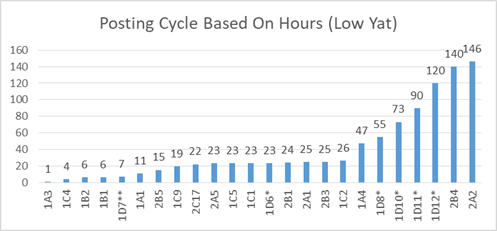
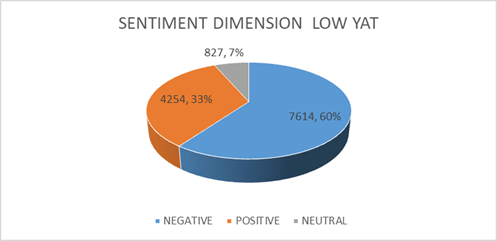
Referring to Table
Referring to table
Referring to figure
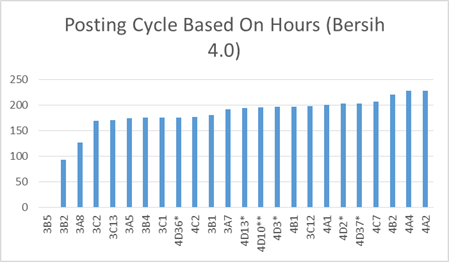
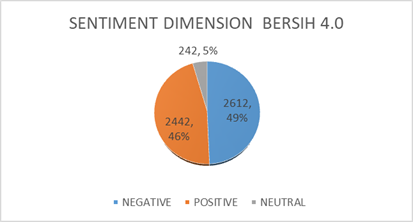
In this study, a post from the monitoring agency with the highest engagement rate will be selected as the central point of before and after the strategy by monitoring agency. Posts that have the highest engagement rate is referred as the best strategy had been implemented by the monitoring agency which mostly affect social media users to click on the post and placed their comments (public opinion). For the case study of Plaza Low Yat racial riot incident, posting from monitoring agency with highest engagement rate belongs to the post with post id 1D7. The date and the time of the post was published was on 12th Of July 2015 at 11.02pm. Therefore, any posts from independent sources, the opinion leader and the media regarding the studied issue before the date and the time of 1D7 posting will be coded as post before strategy of monitoring agency while after date and time of 1D7 posting will be coded as post after monitoring agency strategy.
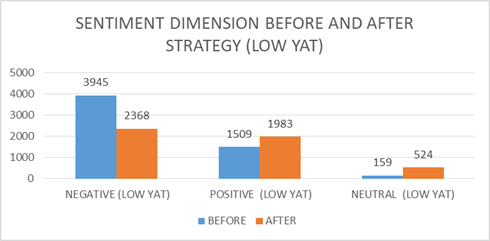
Based on the figure
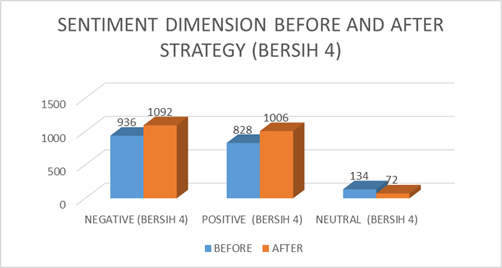
In this study, a post from the monitoring agency with the highest engagement rate will be selected as the central point of before and after the strategy by monitoring agency. Posts that have the highest engagement rate is referred as the best strategy had been implemented by the monitoring agency which mostly affect social media users to click on the post and placed their comments (public opinion). For the case study of Bersih 4.0 rally, posting from monitoring agency with highest engagement rate belongs to the post with post id 4D10. The date and the time of the post was published was on 30th August 2015 at 2.17pm. Therefore, any posts from independent sources, the opinion leader and the media regarding the studied issue before the date and the time of 4D10 posting will be coded as post before strategy of monitoring agency while after date and time of 4D10 posting will be coded as post after monitoring agency strategy.
Referring to Figure
Therefore for both cases the following hypothesis are accepted:
The negative sentiment is the major comments found in the postings of the viral issues studied (H1)
Monitoring strategy is effective if the negative sentiment decrease after the monitoring strategy implemented by the monitoring agency (H2)
The short term monitoring period is more effective than the long term monitoring period (H3)
In this study, a post from the monitoring agency with the highest engagement rate will be selected as the central point of before and after the strategy by monitoring agency. Posts that have the highest engagement rate is referred as the best strategy had been implemented by the monitoring agency which mostly affect social media users to click on the post and placed their comments (public opinion). For the case study of Bersih 4.0 rally, posting from monitoring agency with highest engagement rate belongs to the post with post id 1D7. The date and the time of the post was published was on 12th Of July 2015 at 11.02pm. Therefore, any posts from independent sources, the opinion leader and the media regarding the studied issue before the date and the time of 1D7 posting will be coded as post before strategy of monitoring agency while after date and time of 1D7 posting will be coded as post after monitoring agency strategy.
Referring to the table
There is association / effect among strategy from monitoring agency towards public opinion in social media (H4)
In this study, a post from the monitoring agency with the highest engagement rate will be selected as the central point of before and after the strategy by monitoring agency. Posts that have the highest engagement rate is referred as the best strategy had been implemented by the monitoring agency which mostly affect social media users to click on the post and placed their comments (public opinion). For the case study of Bersih 4.0 rally, posting from monitoring agency with highest engagement rate belongs to the post with post id 4D10. The date and the time of the post was published was on 30th August 2015 at 2.17pm. Therefore, any posts from independent sources, the opinion leader and the media regarding the studied issue before the date and the time of 4D10 posting will be coded as post before strategy of monitoring agency while after date and time of 4D10 posting will be coded as post after monitoring agency strategy.
Referring to the table
There is association / effect among strategy from monitoring agency towards public opinion in social media (H4)
Conclusion
To answer the research question results showed that the response times affect the effectiveness of the monitoring strategy by the monitoring agency whereby shorter monitoring period will contribute to the effectiveness of monitoring strategy.
Referring to the result also we had found that there are correlations and effect among the strategy implemented by the monitoring body towards public opinion in the social media and there were also an effectiveness found in online strategies for the case study of Plaza Low Yat racial riots incident, where results showed the x2 =1135.35, df = 4 was significant at p < 0.05, reflecting a decreased of negative comments and increased of positive and neutral comments However, in the case of Bersih 4.0 rally, the result showed , the x2 = 11:37, df = 4 was significant at p < 0.05 reflecting an increase of negative comments, post online strategies deployment, which resulting in ineffectiveness of online monitoring strategies during crisis.
The Plaza Low Yat Racial Riots Incident, showed a significant decrease of negative comments from social media users after monitoring strategy implemented within a shorter time (146 hours) compared to Bersih 4.0 case study (228 hours), which showed a negative response and ineffectiveness of online crisis monitoring strategies. Therefore, as the conclusion, the study found that all the tested hypothesis can be accepted whereby the results show that
The negative sentiment is the major comments found in the postings of the viral issues studied (H1)
For both cases studied result showed negative sentiment is the major comments found in the selected posting.
Monitoring strategy is effective if the negative sentiment decrease after the monitoring strategy implemented by the monitoring agency (H2)
The result showed vary in the pattern of negative sentiment counts where decease pattern found from Racial Riot case study while increase pattern for Bersih 4.0 racial Rally.
The short term monitoring period is more effective than the long term monitoring period (H3)
Both cases study required different duration for monitoring. And therefore the result was also vary where Racial Riot case study require shorter monitoring period of 146 hours and was effective while Bersih 4.0 Racial Rally required 228 hours of monitoring ending up not effectiveness.
There is an association / influence between the strategy implemented by the monitoring agency towards the public opinion in the social media (H4)
Results from non parametric chi-square test showed that there are association / influence between the strategy implemented by the monitoring agency towards the public opinion in the social media at p<0.05 and df=4 for both cases.
This research findings proves that the online monitoring strategy were effective in managing crisis. With the emerging of online media, this research successfully fill up the gap on crisis management theory and communication theory via the used of API web tool sentiment analysis to keep track the negativity on an issues before it get out of control. Crisis management plan can be done in the most wise and practical way.
References
- Abdoulaye, O. K. and Zanuddin, H. (2017). Online Media’s Role in Public Health Information and Communication Sharing in Cote d’Ivoire (Ivory Coast). ASIA International Multidisciplinary Conference 2017, Universiti Teknologi Malaysia, Skudai, Johor.
- Allen, H. G., et al. (2013) Social Media Release Increases Dissemination of Original Articles in the Clinical Pain Sciences. DOI: https://doi.org/10.1371/journal.pone.0068914
- Almahallawi, W. and Zanuddin, H. (2017). 50 days of War on Innocent Civilian: Ma’an News Agency Coverage of Israeli and Palestinian Conflict. Asia International Multidisciplinary Conference 2017, Universiti Teknologi Malaysia, Skudai, Johor.
- Ambikapathy, M. and Zanuddin, H. (2017). “Gatekeeper or Crisis Manager? Coverage of "Lahad Datu" Conflict”. ASIA International Multidisciplinary Conference 2017, University Technology Mara, Skudai, Johor.
- Beaumont, C. (2008). "Mumbai attacks: Twitter and Flickr used to break news." The Telegraph 27.
- Cheong, J. R. and Zanuddin, H. (2017). MEDIA ATTENTION FOR CLIMATE CHANGE MITIGATION AND ADAPTATION IN MALAYSIA: A Comparative Analysis of Malaysia Chinese Newpapers Coverage. ASIA International Multidisciplinary Conference, University Technology Malaysia, Skudai, Johor.
- Colley, K. L. and Collier, A. (2009). "An overlooked social media tool? Making a case for wikis." Public Relations Strategist 15(2): 34-35.
- Coombs, W. T. (2014). Ongoing Crisis Communication: Planning, Managing, and Responding. Texas, USA, SAGE Publications, Inc.
- Cvijikj, I. P. and Michahelles, F. (2013). "Online engagement factors on Facebook brand pages." Social Network Analysis and Mining 3(4): 843–861.
- Fearn-Banks, K. (2016). Crisis communications: A casebook approach, Routledge.
- Ganjian, M. and Zanuddin, H. (2017). Media, Politicization of Colors and Construction of Identity: The Role of Colors in Social Movements and Revolutions. Asia International Multidisciplinary Conference 2017, University Technology Malaysia, Skudai, Johor.
- Ghazi, J. (2011). "Social Media Made Tunisian Uprising Possible." New America Media 14.
- Hennessy, B. C. (1970). Public Opinion. Belmont, California, Wadsworth Publishing Company.
- Herder, R. and Law, E. B. (2009). "Social media: Embracing the opportunities, averting the risks." Ethos Business Law: 1-9.
- Laurens, A. (2013). Who Likes to Engage? University Park, Pennsylvania, The Pennsylvania State University.
- Lenhart, A. and S. Fox (2009). "Twitterpated: Mobile Americans increasingly take to tweeting." Pew Research Center Publications.
- Liu, B. (2012). "Sentiment Analysis and Opinion Mining." Synthesis Lectures on Human Language Technologies 5(1): 1-167.
- Malakasiotis, P., et al. (2013). Two Stage Sentiment Analysis. Conference on Lexical and Computational Semantics Atlanta, Georgia, U.S.A.
- Marken, G. (2007). "Social media... The hunted can become the hunter." Public Relations Quarterly 52(4): 9-12.
- Mudjirin, A. C. and Zanuddin, H. (2017). Fostering Political Participation Among Students Of Pesantren Through New Media In Madura. ASIA International Multidisciplinary Conference 2017, Universiti Teknologi Malaysia, Skudai, Johor.
- Nelson-Field, K. and Taylor, J. (2012). Facebook fans: A fan for life?, Warc.
- Pang, B. and L. Lee (2004). A sentimental education: sentiment analysis using subjectivity summarization based on minimum cuts. 42nd Annual Meeting on Association for Computational Linguistics Barcelona, Spain, ACM.
- Pang, B. and L. Lee (2005). Seeing stars: Exploiting class relationships for sentiment categorization with respect to rating scales. Association for Computational Linguistics (ACL). , Ann Arbor, Michigan.
- PEW RESEARCH CENTER (2010). "New Media, Old Media: How Blogs and Social Media Agendas Relate and Differ from the Traditional Press." Retrieved Oct, 2, 2015, from http://www.journalism.org/2010/05/23/new-media-old-media/#.
- Quarantelli, E. L. (2005). What is a disaster?: a dozen perspectives on the question, Routledge.
- Robinson, E. (2010). "Following the earthquake in Haiti on Twitter." Washington Post 13.
- Scherp, A., et al. (2009). Leveraging web 2.0 communities in professional organisations. W3C Workshop on the Future of Social Networking; Barcelona, Spain.
- Smith, B. G. (2010). "Socially distributing public relations: Twitter, Haiti, and interactivity in social media." Public Relations Review 36(4): 329-335.
- Stephens, K. K. and Malone, P. C. (2009). "If the organizations won't give us information…: The use of multiple new media for crisis technical translation and dialogue." Journal of Public Relations Research 21(2): 229-239.
- Sutton, J. N., et al. (2008). Backchannels on the front lines: Emergency uses of social media in the 2007 Southern California Wildfires, University of Colorado.
- Thongmak, M. (2015). Engaging Facebook users in brand pages: Different posts of marketing-mix information. International Conference on Business Information Systems, Springer.
- Veil, S. R., et al. (2011). "A work‐in‐process literature review: Incorporating social media in risk and crisis communication." Journal of contingencies and crisis management 19(2): 110-122.
- Watimin, N. H. and Zanuddin, H. (2016). "Sentiment analysis on viral issues in social media." International Journal of Social Science & Human Behavior Study 3(3): 34-37.
- Watimin, N. H. and Zanuddin, H. (2017). Public Opinion Formation: The role of independent media portal during crisis. ASIA International Multidisciplinary Conference 2017, University Technology Malaysia, Skudai, Johor.
- Woolley, J. K., et al. (2010). "The 2008 presidential election, 2.0: A content analysis of user-generated political Facebook groups." Mass Communication and Society 13(5): 631-652.
- Wright, D. K. and Hinson, M. D. (2009). "An updated look at the impact of social media on public relations practice." Public relations journal 3(2): 1-27.
- Zanuddin, H. and Abdoulaye, O.K. (2017). Health Public Relations Campaign and Online News Coverage Focus: Does it help Public Health Policy and the People of Cote d’Ivoire (Ivory Coast)? ASIA International Multidisciplinary Conference, University Technology Malaysia, Skudai, Johor.
- Zanuddin, H. and Almahallawi, W. (2017). Media Framing approach of Israelis and Palestinian Conflict: Ma’an News Coverage on War, Pain and Humanitarian Issues. ASIA International Multidisciplinary Conference 2017, University Technology Malaysia, Skudai, Johor.
- Zanuddin, H. and Alyousef, Y. (2017). Saudi Arabian Government Crisis Management and Prevention Strategies: Has it been Effective to Curb the Presence of Radical Groups in the Social Media? ASIA International Multidisciplinary Conference 2017, University Technology Malaysia, Skudai, Johor.
- Zanuddin, H. and Alyousef, Y. (2017). SOCIAL MEDIA GROOMING: The Relationship of Social Media, Youth and Terrorism in Saudi Arabia. ASIA International Multidisciplinary Conference 2017, University Technology Malaysia, Skudai, Johor.
- Zanuddin, H. and Ambikapathy, M. (2017). VISUAL FRAMING OF “LAHAD DATU” CONFLICT COVERAGE IN MALAYSIAN MAINSTREAM NEWSPAPERS. ASIA International Multidisciplinary Conference 2017, University Technology Malaysia.
- Zanuddin, H. and Ganjian, M. (2017). A Constructivism Approach to Social Movements and the Role of Media in Collaborative Knowledge Construction. ASIA International Multidisciplinary Conference 2017, University Technology Malaysia, Skudai, Johor.
- Zanuddin, H. and Mudjirin, A. C. (2017). Political Information Sharing Pattern and Trend Among Students in the Islamic Boarding School in Madura, Indonesia: A Non-Digital Choice? ASIA International Multidisciplinary Conference 2017, University Technology Malaysia, Skudai, Johor.
- Zanuddin, H. and Mukhtar, N. (2017). Local Product Brand Image: A Case Study of Small and Medium Enterprises in Muar, Johor. ASIA International Multidisciplinary Conference 2017, University Technology Malaysia, Skudai, Johor.
Copyright information

This work is licensed under a Creative Commons Attribution-NonCommercial-NoDerivatives 4.0 International License.
About this article
Publication Date
01 May 2018
Article Doi
eBook ISBN
978-1-80296-039-6
Publisher
Future Academy
Volume
40
Print ISBN (optional)
-
Edition Number
1st Edition
Pages
1-1231
Subjects
Business, innovation, sustainability, environment, green business, environmental issues
Cite this article as:
Zanuddin, H., & Watimin, N. H. (2018). Managing Crisis And Response Times Analysis: Effectiveness Of Online Monitoring Strategy Analysis. In M. Imran Qureshi (Ed.), Technology & Society: A Multidisciplinary Pathway for Sustainable Development, vol 40. European Proceedings of Social and Behavioural Sciences (pp. 157-177). Future Academy. https://doi.org/10.15405/epsbs.2018.05.15

